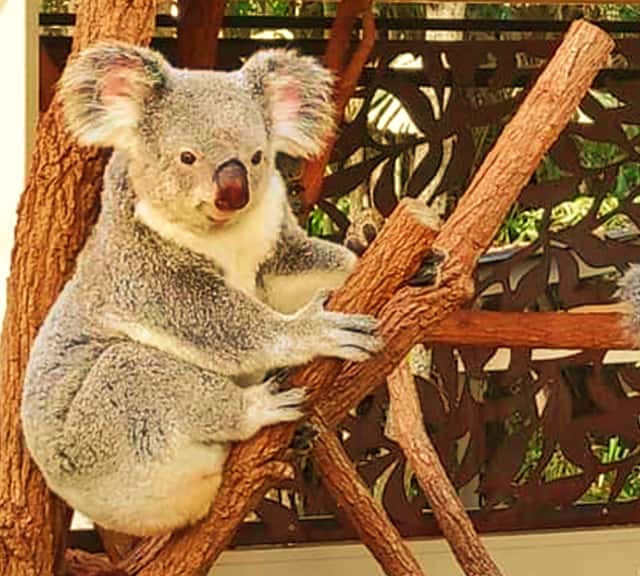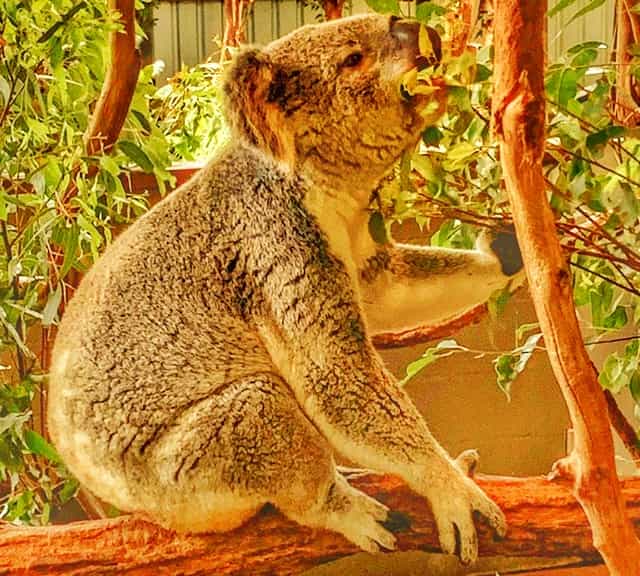Discovery of Koalas
The aboriginal and native people from Australia were the first ones to discover koalas and they discovered them long before the arrival of Europeans at the Australian continent. It is not known when they first discovered koalas, however; these aborigines have been living at the Australian continent for more than 30,000 years.
Koalas were first discovered by the aboriginal and native people of Australia. These people also discovered that koalas do not drink water at all.
When the Europeans reached the Australian continent in the 19th century, the aborigines (comprising of various aboriginal tribes) used to call koalas with a lot of names (more than half a dozen koala names) in their own native languages and they knew all basic information about koalas. For example, these aborigines already had the knowledge about koalas that they do not drink water from the waterholes and on the basis of this observation the natives used to call koalas as cullawines.

But how did the Australian aborigines discovered that koalas do not drink water at all? It has been speculated and assumed that the native Australian inhabitants were hunters. They used to ambush and hunt the Australian animals near the waterholes, where animals used to come for drinking water.
It is assumed that the aboriginal Australian hunters would have learned that unlike many other animals, koalas can never be ambushed near waterholes for hunting.
It is assumed that hunters from the aborigines would have discovered that koalas do not come for drinking near the waterholes and the only way they could be hunted was to reach them directly at the trees which was rather difficult to accomplish. Afterall; this fact that koalas do not drink water at all is considered as one of the most fundamental discoveries about koalas and all credit goes to aborigines who discovered it long ago.

Koalas did enjoy a reasonable degree of acknowledgment and respect within the Australian aboriginal people as well. For an example, koalas used to have such a good reputation among the aboriginal Australians that some tribes used to seek advice from koalas. Among aborigines it was considered as a bad omen to make objects out of koalas' skin.
Koalas were part of the superstitious beliefs, folklore tales, counseling and even good or bad omens among the aboriginal Australian people. These are also key proofs that aboriginal Australian discovered koalas first.
Some aborigine tribes used to believe that if a koala's body doesn't get a proper burial, it will result in droughts and rivers will dry. Similarly; the aboriginal Australians used to believe that koala emerged from a boy who stole water from a tribe and hid himself in tree and became a koala. All of these narratives are the key proofs that aboriginal Australian people were the first ones to discover koalas at the Australian continents.

On the other hand; the modern-day discovery of the Australian koalas took place in the early 19th century. However; some Europeans did have a bit knowledge about koalas in 18th century as well which they knew from the aboriginal Australians. The European settlers reached the Australian continent in 1787 and a few years later, their arrival at the island contributed to the discovery of koalas which resulted in their awareness for the rest of the world.
The modern-day discovery of koalas took place in the beginning of the 19th century. The European settlers arrived at the Australian island in 1810 and some years later they discovered koala.
Furthermore; from the 19th century onwards; rapid discovery and research took place to learn about koalas and they gradually gained reasonable popularity across the globe. Today; koalas are the most popular animals across Australia and they are even more popular in Australia than kangaroos. The discovery of koalas by the aboriginal Australian people only contributed the knowledge about koalas to local tribes while the European settlers' discovery of koalas spread their knowledge all over the world.

Among the modern-day discoverers of koalas, John Price in 1798 was the first European individual who learned about koalas from the aboriginal Australian people. He specifically learned that there is a sloth-like creature which the natives call cullawine. Later in 1802, Francis Barrallier became the first individual review the first ever koala specimen.
John Price was the first individual who discovered and learned about koalas from the native Australians while Mr. Bauer was the first individual to accurately draw a koala specimen.
Onwards; Mr. Bauer was the first individual to draw a koala and accurately detailed its description with his companions named as Robert Brown and Mathew Flinders. All of these individuals from John Price to Bauer and his team are considered as one of the modern-day discoverers of the Australian koalas.

Lastly; despite the discoveries of hundreds of animals from the Australian continent, the discoveries of kangaroos and koalas are considered as the most iconic ones. Kangaroos are considered as the national animals and pride of Australia while koalas are the most popular animals across Australia.
The discovery of koalas and kangaroos are the most iconic ones from the Australian continent. Furthermore; even today, new discoveries about koalas are revealed every other week.
Today there are more than hundreds of thousands information sources about koalas in the form of research papers, periodicals, newspaper sources and books etc. Furthermore; new revelations about koalas are updated almost every other week as more and more researches are taking place to discover new traits of these amazing animals. People also keenly take interest about this cutest animal of the Australian continent.

Liger Articles
Marsupials vs. Placental Mammals
Koalas are most popular animals in Australia
Koalas are more popular as compared to Kangaroos
Koalas and their Dominant Nose
Button Shaped Fascinating Eyes of the Koalas
Core Recognizing Features of Koalas
Koalas are the largest tree climbing Mammals in Australia - Koalas as Arboreal
Sizes of Koalas from Queensland, Australia
Sizes of Koalas from Australia's Victorian Origin
Difference between Queensland and Victorian Koalas
Average Weights of Male Koalas
Weighing Male vs Female Koalas
Male Koalas have Loudest of voice among all Australian Mammals
Origin of Koalas & their Evolution
Koalas Population Increased at the end of 20th century
Historical Evolution of the Koalas - A Physical Perspective
Koalas and their Aboriginal and Native Names
It Took 10 years for Aboriginal Australians to Spot and Recognize Koalas
Koalas Live Hardest and Toughest Lives Among all animals
Koalas Tooth Decay through its Abrasive Diet
Koalas Diet is Fully Poisonous and Toxic
Koalas' Food Eucalyptus has Lower Nutrition
Koalas have Lower Energy Levels
Koalas - When Occasionally Spotted on other Leaves for their Food
Why Koalas drink little or no Water?
Koalas & their Advanced Digestive Mechanisms
Why Koalas Sleep more than 20 Hours a Day?
Koalas Lack Energy and Strength
Koala's Tooth from Growth till Tooth Decay
Young Koalas are Better Chewers as Compared to Mature and Elderly Koalas
Why Most Koalas Die of Starvation?
Heat Exhaustion and Heat Strokes among Koalas
Do Koalas lack Intellectual Abilities?
Koalas and their Sense of Smell
Koalas Love Fresh Eucalyptus Leaves as their Food
Koalas' Eucalyptus Leaves' Preferences during summers and Winters
Koalas' Preference for Leaves Having Higher Nitrogen Levels
Koalas Prefer Big Eucalyptus Trees and Love to Stay at Trees' tops.
Koalas Prefer to Live in Areas that have Good Soil and Fertile Lands
Koalas' Per Day Food Consumption
Koalas Food Consumption Depends upon their Body Size
Lactating Female Koalas Consume More Food as Compared to the Normal Female Koalas
Koalas Consume More Food during Winters as Compared to Summers
Female Koalas are very Selective Regarding their Leaf Selection and Food Consumption.
A Baby Koala Joey Lives in her Mother's Pouch for 8 to 9 Months
Gestation Period within Female Koalas
Breeding Behaviors of the Female Koalas
The Size of the Baby Koala Joey at the time of its Birth
Weight of the Baby Koala Joey at the Time of its Birth
At Birth the Baby Koala Joey Travels from Cloaca into their Mother's Pouch
Newborn Koala Joeys have Well-Established Sense of Smell
Koala Joey keeps his Head Inside its Mother's Pouch for 6 Months
Complete Shape and Body Development of the Koala Joey
Pap - The first solid food of the Koala Joeys
When Does Tooth Emerge for Baby Koala Joey?
Aggressive Behavior of Mother Koalas towards their Joeys
Queensland Offers Less Nutritional Values for Koalas
How long does Koalas live? Age of the Koala
Female Koalas Live More than Male Koalas
What is the Average Age of the Male Koala?
Average Ages of the Female Koalas
For How Long a Female Koala can Give Birth to the Koala Joeys?
How many times female Koalas give birth?
Koalas and Australia's Bushfire
Koalas' fur quickly gets rid of rain water
Koalas Resting and Sleeping Postures and Positions during the Hot Summer Seasons
Winter Season and Sleeping Postures of Koalas
Koalas' Urination during Summer and Winter Seasons
Koalas and their Specialized Claws
How does a Koala regulate its Body Temperature?
Food Consumption and Feeding Timings of the Koalas
Koalas Always Prefer Eucalyptus Leaves from the Tree top
How does a Koala Grooms itself?
Koalas' Territories and ranges within Australia's Victorian Areas
Koalas' Territories and Ranges within Australia's Queensland Areas
Behavior of the Alpha Dominant Male Koala
Aggressiveness of Female Koalas
Scent Marking Behavior of the Male Koalas
Mating Strategy of the Male Koalas
Fights and Territorial Encounters of Male Koalas
Sounds and Vocalizations of Male Koalas
Sounds and Vocalization of the Female Koalas
Koalas and their Facial Expressions
Breeding Ages of the Male and Female Koalas
Factors Influencing the Success of Koalas' Fertility Rates
Behavior of the young and adolescent Koala Joey
When Does a Mother Koala Says Goodbye and Leaves the Young Koala Joey?
Playful Behavior of the Young Koala Joeys
Koalas - Mating Season and Mating Months
Koala Informationen, Bilder, Neuigkeit, und Erforschung
Коала - сумчатый млекопитающий